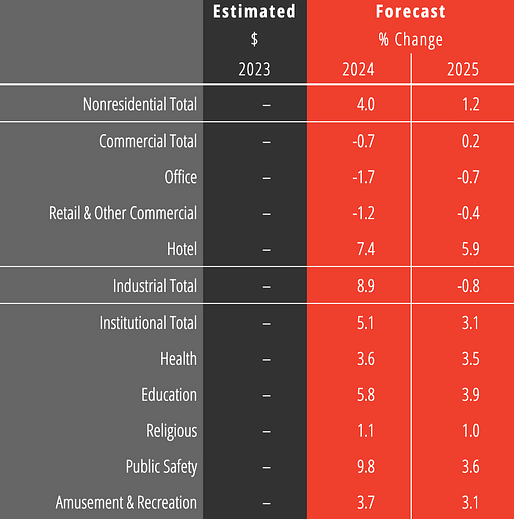
Spending on nonresidential buildings will see a minor 4% increase in 2024 despite a 20% increase in 2023, according to the AIA’s latest Consensus Construction Forecast. In 2025, meanwhile, the pace is expected to slow to just over 1% growth.
Across key sectors, manufacturing construction will see a 10% increase in 2024, while institutional construction will see mid-single-digit gains over the next two years. Spending on commercial construction is expected to be flat for the next two years.
The strong performance of manufacturing construction continues from 2023, where it accounted for almost 30% of overall spending on nonresidential buildings. Last year also saw spending on offices increase by 8%, while hotels increased by 21% and retail and other commercial facilities increased by 7%. Elsewhere, healthcare and education spending both rose by 13%.

In analyzing the strong performance of the manufacturing sector, AIA points to legislation including the CHIPS and Science Act which increased manufacturing spending on high-tech hubs and semiconductor manufacturing, and the Inflation Adjustment Act, which gave financial incentives for energy-efficient reconstruction.
Accounting for the expected slowdown of construction over the next two years, AIA points to rising long-term interest rates which have led to a tightening on construction lending. Higher construction input costs have also contributed to the slowdown, with input prices remaining 35% to 40% higher than pre-pandemic rates. Meanwhile, construction labor costs are continuing to rise at a 4% annual pace.

Elsewhere, a decline in commercial property values may also discourage construction, with AIA citing figures that office values have declined almost 15% over the past year, while apartments are down 12%.
Finally, AIA points to wider structural changes in the workplace as impacting construction trends. “While construction is a notoriously cyclical industry, some of the current trends affecting the office and retail sectors are more structural than cyclical,” AIA explains. “At present, about 30% of paid workdays nationally are worked remotely. Remote work seems to be stabilizing at around this level. Prior to the pandemic, the share of days working remotely was under 5%, underscoring the need of most companies for less office space.”
AIA’s analysis comes on the same week that US Census Bureau data found that residential construction activity declined in 2023. The latest AIA Architecture Billings index has also remained below 50 for the fourth consecutive month, according to the latest AIA figures.
No Comments
Block this user
Are you sure you want to block this user and hide all related comments throughout the site?
Archinect
This is your first comment on Archinect. Your comment will be visible once approved.